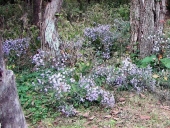I know there is a lot about this already, here and there on the forum, but I think it is such an interesting and important topic I thought I'd start another
thread to talk about some of my work and hopefully hear about the work others are doing.
I already have a couple threads on some of my individual projects and I do need to get back to updating those threads but will do that later and won't include them here, but you can check them out if you want.
Reed's Sweet Potatoes and
Reed's Ohio Valley Flint Corn.
I wish I had not used the phrase "ultimate survival crop" on the sweet potatoes because I don't know that it is, but I was new. If an admin with the ability to do so wanted to change that to "Reed's
Landrace Sweet Potatoes" I'd be much obliged.
My first landraces were mostly flowers, wildflowers actually, because when I first came here, I didn't have any flowers and being cheap and poor I wasn't going to buy any. These include Columbine, Virginia Blue Bells, some kind of bright red star shaped flower and others I never bothered to identify. They don't seem to mind that I don't know what they are, they grow anyway. I think my Columbine later got mixed up with some tame ones and made a bunch of interesting new kinds.
One of my favorites of all these is my Wild Asters. In them I select for large flowers of varied colors. White is the least common so whenever a solid white one shows up, I always make sure its seeds find good spots to sprout. But they don't breed true, so it's always a nice surprise to find a solid white one.



In the garden I have lots of what I would consider landraces that just kind of happened on their own and are basically wild. Those include among others, dill, mustard, turnips, and radishes. The radishes are probably the first of these where I tried to do something on purpose. I don't care all that much for radishes, I mostly grew them for soil improvement, but the woman here does like them so when I decided to let them make seed, I was pleasantly surprised to discover that I really like the seed pods. I was even more surprised that when one volunteers the correct time to mature a nice
root corresponding with the first hard frosts of fall that they are also very good. Nice and crisp with a pleasant flavor.

After reading Suzann Ashworth's "Seed to Seed" I was discouraged about seed saving overall because of the issues with population sizes and inbreeding depression, especially with the corn I mentioned earlier. That's when I go the idea that just letting things cross up might fix that and I started researching to see what I might find out.
That was pretty much a dead end until I finally hit a search term that took me to some articles on Mother Earth News by a fellow named
Joseph Lofthouse. That's when I first saw the term "landrace". So, I wasn't crazy after all and if I was, I wasn't the only one. This guy had already been doing this and had even given it a name. The Mother Earth articles took me to Joseph Lofthouse's web site and on to some other plant breeding and
gardening fours where I started learning all kinds of interesting things.
Now most of my vegetable crops are grown in the
landrace style. I say most because I do have a few things, my KY Wonder beans for example that I keep in a pure state because I like them that way. Even they, however after being grown and saved by me for about 40 years have adapted. They don't look or taste exactly like those that other people grow from purchased seed, mine are better!
A couple of my favorite examples of my more purposeful landrace breeding are my
water and musk melons. For a long time, I had grown Moon & Stars watermelons and Minnesota Midget muskmelon. They were OK but I wanted to mix it up some so I was able to obtain seed of both species from a friend in Canada and from Joseph.
Now I have the most wonderful mixed-up landraces of both. I select for smaller size, more compact growth and fast maturity in both species but mostly for wonderful flavor. I had never in life seen a yellow watermelon and didn't even know the existed. I think that the yellow ones that now show up probably came from the seeds I got from Joseph, but I don't save seed just from them. I like not knowing what color one is until I chop it open.


In my muskmelons something really weird showed up. I have no clue where it came from as both Joseph and my friend in Canada denied involvement. Well, I'm sure it didn't come from my own Minnesota Midget so one of them is responsible. Either that or it is an example of spontaneous wonderfulness, that might happen from time to time when you throw out the restraints of "pure variety" seed saving. It's a weird looking thing, hard and green and a little unpleasantly fuzzy on the outside. But, if you pick it while it's still green and rub off the fuzz it is in my opinion, the ambrosia of muskmelons. I named it green meany for its icky fuzz and extremely tough skin.

Are you growing "landrace" vegetables in your garden?

 10
10




 2
2




 4
4









